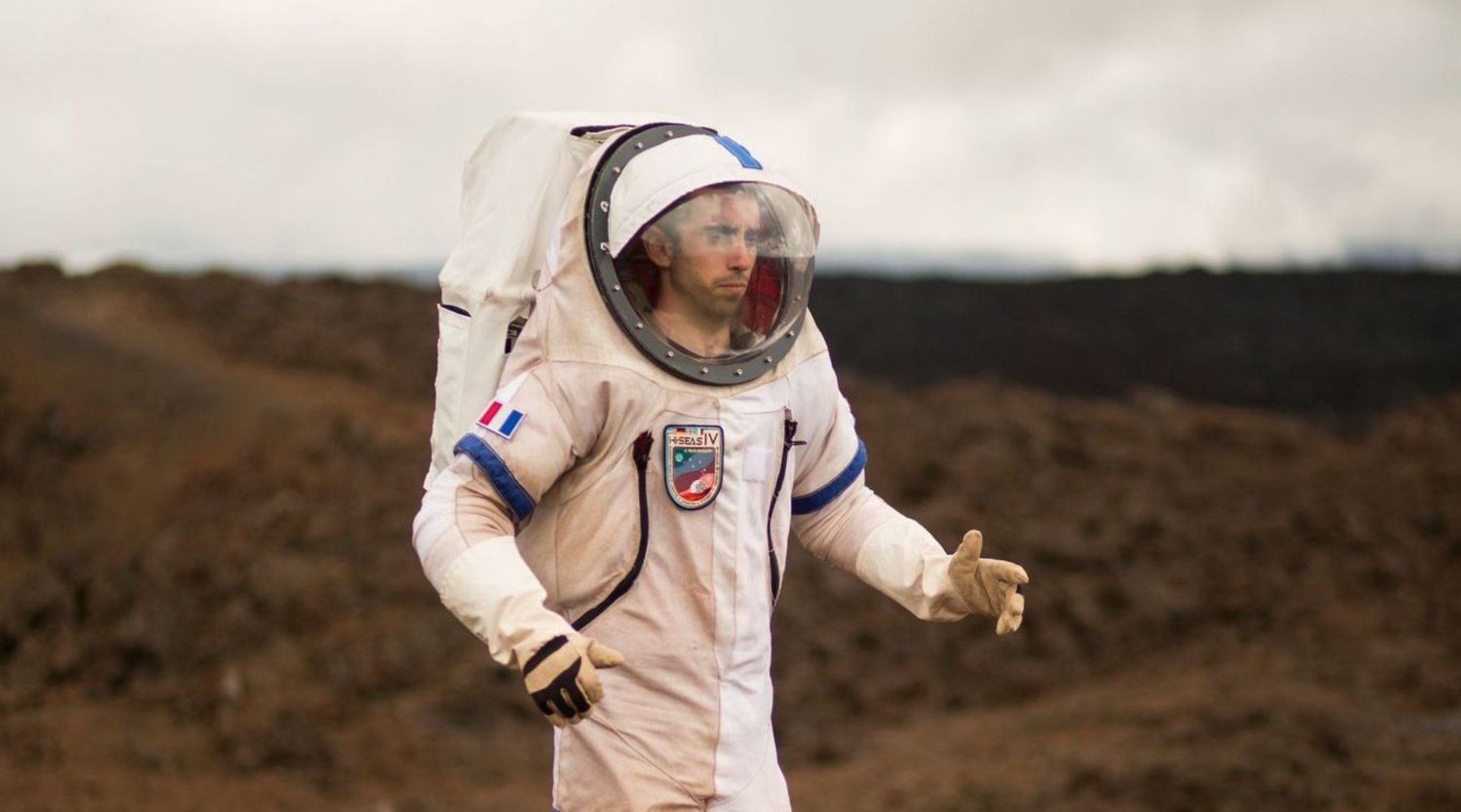Humanoid robots at the reception desk of the Henn-na Hotel in Nagasaki Prefecture, Japan. This is the first hotel with humanoid robots in the world. © Alberto Giuliani, Winner, LensCulture Emerging Talent Awards 2016.
Mauna Kea landscape in Hawaii. NASA and many other private companies use this landscape to introduce humans and machines to what life on other planets could look like. © Alberto Giuliani, Winner, LensCulture Emerging Talent Awards 2016.
Kai Shwaltenberg, geologist and biologist. His dives into the Arctic Ocean are commissioned by the world's leading universities. On these dives, he gathers information that is used to map the changing climate. Ny-Alesund Scientific Base, Svalbard. © Alberto Giuliani, Winner, LensCulture Emerging Talent Awards 2016.
Alcoa Life Extension, Phoenix, Arizona. The theater where human bodies (left) or just the heads (right) are frozen and cryopreserved. Around 600 people from around the world are already waiting for their new lives in nitrogen baths. © Alberto Giuliani, Winner, LensCulture Emerging Talent Awards 2016.
Cryopreservation at the Cryonic Institute of Michigan, Detroit. This is the oldest center in the world, where Robert Ettinger, father of cryonics, did his first studies. Hillary is the 24-year-old funeral manager. She is in charge of freezing the patients' bodies. © Alberto Giuliani, Winner, LensCulture Emerging Talent Awards 2016.
Geodetic Arctic Station and Antennas. Receiving signals from several quasars that are billions of light years away, the scientists here explore the universe. Ny-Alesund Scientific Base, Svalbard. © Alberto Giuliani, Winner, LensCulture Emerging Talent Awards 2016.
NASA Hi-Seas IV mission. An astronaut simulates life on Mars from the top of Mauna Loa Volcano, Hawaii. © Alberto Giuliani, Winner, LensCulture Emerging Talent Awards 2016.
The Climate Change Tower is the antenna built by the EU to monitor climate change. Svalbard. © Alberto Giuliani, Winner, LensCulture Emerging Talent Awards 2016.
Human bodies are frozen in big white cylinders at the Cryonic Institute, Detroit, USA. They wait for their new lives—as soon as science figures out how to wake them up. © Alberto Giuliani, Winner, LensCulture Emerging Talent Awards 2016.
Caprine Verseux is a French astronaut and astro-biologist. He took part in the NASA Hi-Seas IV mission, simulating one year on Mars. Mauna Loa Volcano, Hawaii. © Alberto Giuliani, Winner, LensCulture Emerging Talent Awards 2016.
Glenn's Couple. Both of them decided to be cryopreserved at the Alcor Life Extension facility in Phoenix, Arizona. They wanted to love each other in the next life, too. Picture on the wall in the Alcor waiting room. © Alberto Giuliani, Winner, LensCulture Emerging Talent Awards 2016.
The Mauna Kea observatory is one of the most important space observatories in the world. In the coming years, in this same place, a new observatory will be built. It will be the most powerful site on the planet, able to listen for life in galaxies far, far away. © Alberto Giuliani, Winner, LensCulture Emerging Talent Awards 2016.
Scientific Base in Ny-Aalesund (Svalbard). Renè Burgì is a French scientist. Every night he send a laser ray into the stratosphere to monitor climate change. © Alberto Giuliani, Winner, LensCulture Emerging Talent Awards 2016.
The Global Seed Vault in Longyearbyen. A bunker built to secure the global biodiversity against any catastrophic or accidental loss. © Alberto Giuliani, Winner, LensCulture Emerging Talent Awards 2016.
The Global Seed Vault in Longyearbyen. Five nuclear attack-proof steel doors protect the cells where the seeds are stored. © Alberto Giuliani, Winner, LensCulture Emerging Talent Awards 2016.
Humanoids robots in Japan. This Geminoid robot reports the news from all over the world 24/7. © Alberto Giuliani, Winner, LensCulture Emerging Talent Awards 2016.
Scientific Base in Ny-Aalesund (Svalbard). A map of the ice melting. © Alberto Giuliani, Winner, LensCulture Emerging Talent Awards 2016.
Humanoid robots in Japan at the National Museum of Emerging
Science and Innovation (Miraikan). Here, people can experience Telenoid, a little humanoid that acts like a baby. © Alberto Giuliani, Winner, LensCulture Emerging Talent Awards 2016.
Cryoconservation at the Cryonic Institute of Michigan, Detroit. Waiting room. The patients in the pictures are cryopreserved. © Alberto Giuliani, Winner, LensCulture Emerging Talent Awards 2016.
NASA Hi Seas IV, the one year simulation of life on Mars. Mauna Loa Volcano (Hawaii). Sheina Gifford is the doctor for the crew and one of the main NASA experts studying the human body's reaction to Mars. © Alberto Giuliani, Winner, LensCulture Emerging Talent Awards 2016.
Eden Project, UK. A tropical forest under the world's biggest biosphere. © Alberto Giuliani, Winner, LensCulture Emerging Talent Awards 2016.
Cryoconservation, ALCOR Life Extension Foundation, Scottsdale, Arizona. Max More, founder and President, in front of the door that leads to the bodies. © Alberto Giuliani, Winner, LensCulture Emerging Talent Awards 2016.
The Eden Project (UK), the world's biggest biosphere built for educational purposes, has become a way to protect biodiversity from extinction. © Alberto Giuliani, Winner, LensCulture Emerging Talent Awards 2016.
Humanoids robots in Japan. Hiroshi Ishiguro at Osaka University. Professor Hiroshi Ishiguro posing with his humanoid copy. The robot 'teaches' class to his students while he is busy. © Alberto Giuliani, Winner, LensCulture Emerging Talent Awards 2016.
Scientific Base in Ny-Aalesund (Svalbard). A laser ray goes through the stratosphere to report the pollution in the highest clouds. © Alberto Giuliani, Winner, LensCulture Emerging Talent Awards 2016.



